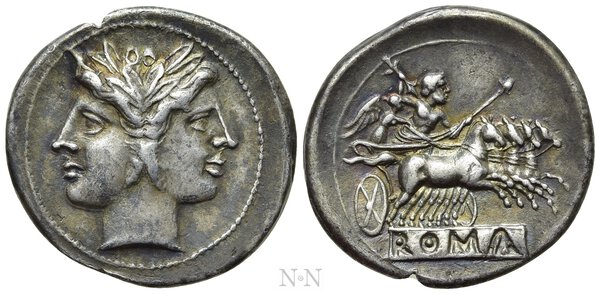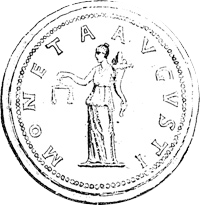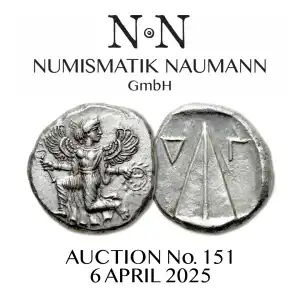Asta LIVE: https://www.biddr.com/auctions/numismatiknaumann


ANONYMOUS. Didrachm or Quadrigatus (Circa 225-214 BC). Rome.
Obv: Laureate head of Janus.
Rev: Jupiter, holding sceptre and thunderbolt, in quadriga driven by Victory right; ROMA incuse on tablet in exergue.
Crawford 28/3; HN Italy 334; RBW 64.
Rome's earliest bronze and silver coinage dates not earlier than the end of the 4th century BC. Produced initially in small quantities, they follow the pattern and weight values of Neapolitan coinage, so they are traditionally called 'Romano-Campananian' series. This occurred mainly after the stipulation of the 'foedum aequum', an agreement sanctioned between Rome and Neapolis in 326, at the time of the Second Samnite War, which marked the beginning of the Roman conquest of southern Italy. The period in which Rome began to produce coinage, between the second conflict with the Samnites until the end of the Punic Wars, coincides with the most intense phase of Roman expansion, implemented through the foundation of colonies and a widespread network of alliances. These issues responded to the need to meet the costs of military enterprises and subsequent public works in occupied territories. After the Campanian-influenced phase, Rome reorganized its monetary structure around the middle of the third century, introducing fixed images on silver series, with the introduction of the Quadrigatus. This silver coin on the obverse bears the youthful head of two-faced Janus and on the reverse a quadriga; it is flanked by the first gold issues, which, because of the depiction on the reverse, are called the 'oath' series. The precise dating of this restructuring of the monetary system is still a matter of debate; however the prow symbolizes an important naval victory, achieved at the time of the wars against the Carthaginians, when the Romans achieved their first significant victories on the sea. Quadrigate production is particularly impressive, probably spread over several mints besides Rome (as in Campania and Sicily). Its chronology, usually placed by scholars between 225 and 214 BC, may be broader to explain the abundance of issues. With the quadrigatus, which over time, like the silver coin series of Syracuse of the same years, is subject to a gradual decline in weight (from 6.60g to 4.50g), the first phase of Roman coinage comes to an end. Rome thus produced silver and bronze minted coinage related to the tradition of Greek cities and, at about the same time, heavy cast bronze series typical of Italic areas. Its colonies in non-Hellenic areas, where the use of metal by weight was rooted, also produced heavy bronze coinage, with the local value of the pound and its subdivisions.
Condition: Good very fine.
Weight: 6.64 g.
Diameter: 24 mm.
Obv: Laureate head of Janus.
Rev: Jupiter, holding sceptre and thunderbolt, in quadriga driven by Victory right; ROMA incuse on tablet in exergue.
Crawford 28/3; HN Italy 334; RBW 64.
Rome's earliest bronze and silver coinage dates not earlier than the end of the 4th century BC. Produced initially in small quantities, they follow the pattern and weight values of Neapolitan coinage, so they are traditionally called 'Romano-Campananian' series. This occurred mainly after the stipulation of the 'foedum aequum', an agreement sanctioned between Rome and Neapolis in 326, at the time of the Second Samnite War, which marked the beginning of the Roman conquest of southern Italy. The period in which Rome began to produce coinage, between the second conflict with the Samnites until the end of the Punic Wars, coincides with the most intense phase of Roman expansion, implemented through the foundation of colonies and a widespread network of alliances. These issues responded to the need to meet the costs of military enterprises and subsequent public works in occupied territories. After the Campanian-influenced phase, Rome reorganized its monetary structure around the middle of the third century, introducing fixed images on silver series, with the introduction of the Quadrigatus. This silver coin on the obverse bears the youthful head of two-faced Janus and on the reverse a quadriga; it is flanked by the first gold issues, which, because of the depiction on the reverse, are called the 'oath' series. The precise dating of this restructuring of the monetary system is still a matter of debate; however the prow symbolizes an important naval victory, achieved at the time of the wars against the Carthaginians, when the Romans achieved their first significant victories on the sea. Quadrigate production is particularly impressive, probably spread over several mints besides Rome (as in Campania and Sicily). Its chronology, usually placed by scholars between 225 and 214 BC, may be broader to explain the abundance of issues. With the quadrigatus, which over time, like the silver coin series of Syracuse of the same years, is subject to a gradual decline in weight (from 6.60g to 4.50g), the first phase of Roman coinage comes to an end. Rome thus produced silver and bronze minted coinage related to the tradition of Greek cities and, at about the same time, heavy cast bronze series typical of Italic areas. Its colonies in non-Hellenic areas, where the use of metal by weight was rooted, also produced heavy bronze coinage, with the local value of the pound and its subdivisions.
Condition: Good very fine.
Weight: 6.64 g.
Diameter: 24 mm.


